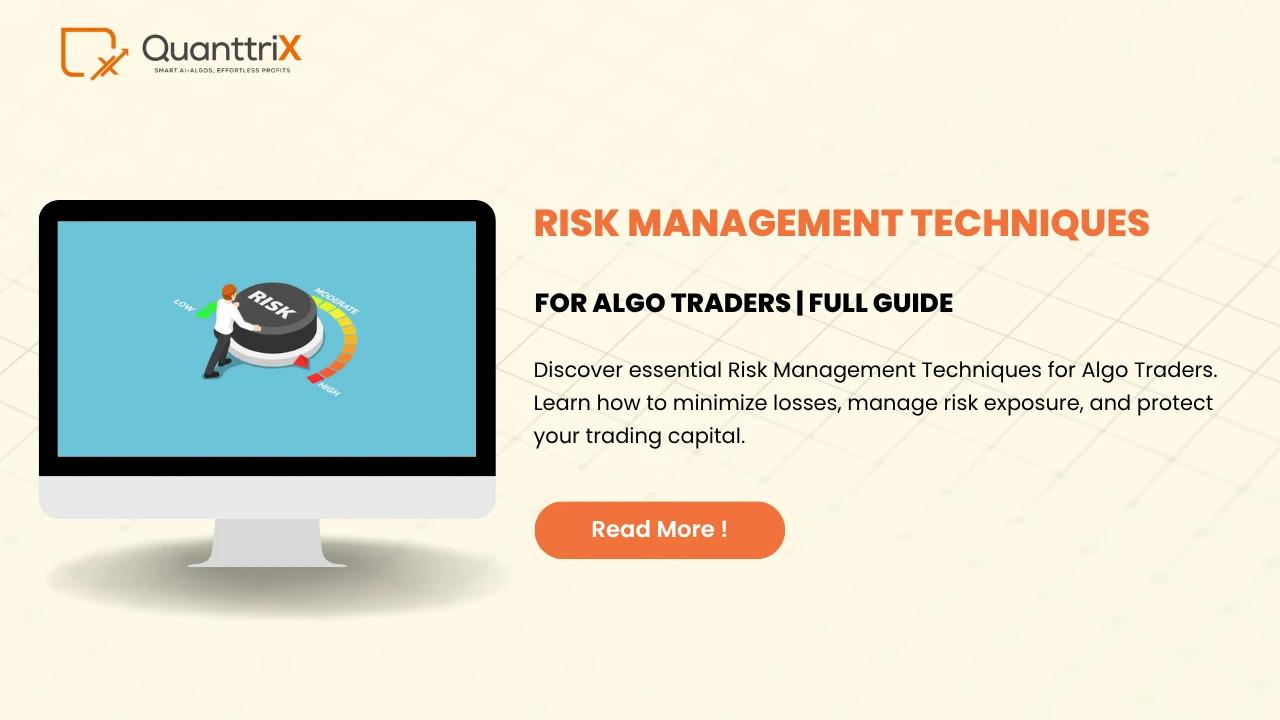Risk Management for Algo Traders | Safe Algorithmic Trading

Risk Management Techniques for Algo Traders
Introduction
Have you ever wondered why some traders thrive while others lose everything overnight? In the fast-moving world of algo traders, it’s not just about building a profitable trading algorithm or choosing the best algorithmic trading software—it’s about how well you manage risk.
Think of trading like driving a race car. The engine (your trading algorithm) determines your speed, but the brakes (your risk management strategies) decide whether you’ll actually make it to the finish line safely. Without good brakes, even the fastest car will crash.
In this article, we’ll take a deep dive into risk management techniques designed for algo traders. Whether you’re new to the concept of algorithmic trading or already building systems, you’ll learn simple yet effective ways to protect your capital and grow steadily over time.
Discover risk management techniques for algo traders, using a smart trading algorithm and reliable algorithmic trading software to succeed safely.
Understanding Risk in Algorithmic Trading
Before we talk about techniques, let’s define risk. In algo trading, risk is the possibility of losing money or facing unexpected outcomes due to market fluctuations, software glitches, or poorly designed strategies.
Unlike manual traders, algo traders do not rely on emotions but on coded rules. However, this does not eliminate risks; it only changes their nature. Instead of emotional mistakes, risk might come from over-optimization, network issues, or sudden market crashes.
Why Risk Management Matters for Algo Traders
Imagine building the best trading algorithm that predicts prices with 70% accuracy. Sounds amazing, right? But if you risk too much on each trade, one bad streak can wipe out your entire account.
Effective risk management ensures that you survive the bad times and stay alive long enough to benefit from the good times. It’s not about eliminating risk—it’s about controlling it.
Common Risks in Algorithmic Trading
-
Market Risks: Unexpected price moves and volatility.
-
Technology Risks: Internet outages, software bugs, or data feed errors.
-
Overfitting Risk: A model that works perfectly on past data but fails in live markets.
-
Liquidity Risks: Difficulty in buying or selling assets without affecting prices.
-
Execution Risks: Slippage (difference between expected and actual trade price).
Developing a Strong Trading Algorithm
A strong trading algorithm should have:
-
Clear entry and exit rules
-
Risk and reward ratios built in
-
Stop-loss conditions for worst-case scenarios
-
Flexibility to adapt to market conditions
Remember: an algo trader should design systems that don’t just chase profit but also account for potential losses.
The Role of Algorithmic Trading Software
Your choice of algorithmic trading software is like choosing the car you’ll drive in a race.
Good software helps with:
-
Backtesting historical data
-
Real-time execution
-
Risk monitoring and alerts
-
Integration with multiple brokers
Position Sizing and Capital Allocation
Would you risk 50% of your money on a single trade? Of course not!
Position sizing is about deciding how much capital to risk per trade. Common approaches include:
-
Fixed Percentage Method: Risk 1–2% of account balance per trade.
-
Kelly Criterion: A mathematical formula balancing profits vs. risk.
-
Volatility-Based Sizing: Aligning trade size with market volatility.
Stop-Loss and Take-Profit Strategies
Think of a stop-loss as a seatbelt—it protects you from catastrophic damage.
-
Stop-Loss Orders: Automatically sell when losses reach a set level.
-
Trailing Stops: Move your stop-loss level as profits increase.
-
Take-Profit Orders: Lock in gains before markets reverse.
Diversification Across Assets and Strategies
Putting all your money into one strategy is like putting all your eggs in one basket.
Diversify by:
-
Trading multiple asset classes (stocks, forex, crypto).
-
Running different strategies (trend-following, mean-reversion, arbitrage).
-
Spreading across different timeframes (short-term and long-term).
Backtesting and Forward Testing
Backtesting is like rehearsing before a big show. You test your trading algorithm using past market data.
But beware—past performance doesn’t guarantee future results. That’s where forward testing (paper trading in real-time without risking money) comes in handy to validate your strategy under live conditions.
Monitoring Real-Time Risks
Algo traders need a control room mindset. Constant monitoring helps prevent huge losses caused by sudden events like policy announcements, flash crashes, or technical failures.
Many algorithmic trading software solutions now come with built-in dashboards, alerts, and even automatic fail-safes that pause trading during unusual conditions.
Market Volatility and Adaptive Strategies
Markets are never static. What works during a bull run might fail during a crash.
Algo traders can build adaptive models that:
-
Adjust position size based on volatility.
-
Switch strategies depending on trending vs sideways markets.
-
Pause trading when market conditions deviate too much from normal.
Psychological Risk vs Algorithmic Discipline
Unlike manual trading, algo systems remove emotions like fear and greed. But the trader still faces psychological risks such as:
-
Over-intervening with their algorithm.
-
Shutting down systems during drawdowns.
-
Over-optimizing after short-term results.
Good discipline means trusting your tested system and letting the trading algorithm do its job.
Risk Controls Built into Trading Software
Modern algorithmic trading software lets users set:
-
Daily Loss Limits
-
Maximum Position Sizes
-
Circuit Breakers to halt trading during extreme losses
These features act like airbags in a car—extra protection when things go wrong.
Continuous Optimization and Evaluation
Risk management is not a one-time setup. Markets evolve, your algo trading strategies must evolve too.
Regularly update:
-
Backtests with fresh data
-
Risk thresholds
-
Portfolio rebalancing
-
Execution algorithms for improved performance
Conclusion + Key Takeaways
In the end, successful algo traders are not gamblers but risk managers. Building a profitable trading algorithm is only half the battle. The real success lies in protecting your capital, staying consistent, and surviving long enough to benefit from growth opportunities.
Remember:
-
Risk is unavoidable but controllable.
-
Diversification, stop-losses, and position sizing are your best friends.
-
Trust your system, but keep monitoring and optimising.
Think of it like building a fortress around your money. Your trading algorithm may be the sword, but your risk management is the shield that keeps you in the game.
FAQs
1. Why is risk management important for algo traders?
Because without it, even a profitable strategy can lead to massive losses during bad market conditions. Risk management ensures survival.
2. What role does algorithmic trading software play in risk control?
It provides built-in tools like loss limits, real-time monitoring, and execution rules that protect traders from unexpected risks.
3. How much capital should an algo trader risk per trade?
Ideally, 1–2% of account balance. Larger amounts increase the chance of blowing up the account.
4. What is the difference between backtesting and forward testing?
Backtesting uses historical data, while forward testing runs strategies in real-time (demo mode) to check actual performance.
5. Can diversification reduce risks in algorithmic trading?
Yes, spreading across multiple assets and strategies reduces the chance of total loss when one system or market fails.
- Art
- Causes
- Crafts
- Dance
- Drinks
- Film
- Fitness
- Food
- Games
- Gardening
- Health
- Home
- Literature
- Music
- Networking
- Other
- Party
- Religion
- Shopping
- Sports
- Theater
- Wellness


